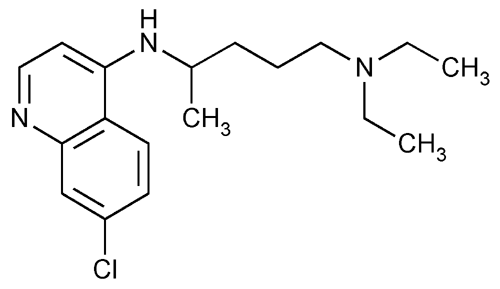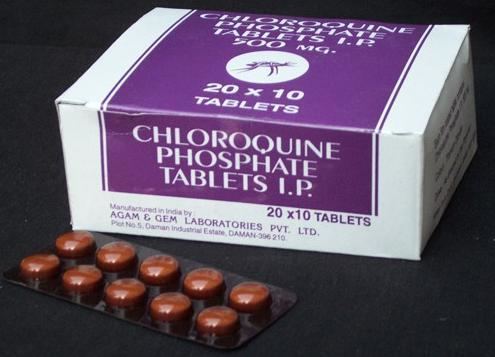Pronunciation /ˈklɔːrəkwɪn/ AHFS/Drugs.com Monograph ATC code P01BA01 (WHO) Molar mass 319.872 g/mol | Trade names Aralen License data US FDA: Chloroquine Legal status US: ℞-only CAS ID 54-05-7 | |
 | ||
Pharmacology malaria antimalarials
Chloroquine is a medication used to prevent and to treat malaria in areas where malaria is known to be sensitive to its effects. Certain types of malaria, resistant strains, and complicated cases typically require different or additional medication. It is also occasionally used for amebiasis that is occurring outside of the intestines, rheumatoid arthritis, and lupus erythematosus. It is taken by mouth.
Contents
- Pharmacology malaria antimalarials
- Hydroxy chloroquine plaquenil in lupus
- Malaria
- Amebiasis
- Rheumatic disease
- Adverse effects
- Pregnancy
- Elderly
- Drug interactions
- Overdose
- Resistance in malaria
- Pharmacology
- Antimalarial
- Other
- Names
- History
- Research
- References

Common side effects include muscle problems, loss of appetite, diarrhea, and skin rash. Serious side effects include problems with vision, muscle damage, seizures, and low blood cell levels. It appears to be safe for use during pregnancy but has not been well studied in this group of people. Chloroquine is a member of the drug class 4-aminoquinoline. It works against the asexual form of malaria inside the red blood cell.
Chloroquine was discovered in 1934 by Hans Andersag. It is on the World Health Organization's List of Essential Medicines, the most effective and safe medicines needed in a health system. It is available as a generic medication. The wholesale cost in the developing world is about 0.04 USD. In the United States it costs about 5.30 USD per dose.

Hydroxy chloroquine plaquenil in lupus
Malaria

Chloroquine has long been used in the treatment or prevention of malaria from Plasmodium vivax, P. ovale, and P. malariae. After the malaria parasite Plasmodium falciparum started to develop widespread resistance to it.
Chloroquine has been extensively used in mass drug administrations, which may have contributed to the emergence and spread of resistance. It is recommended to check if chloroquine is still effective in the region prior to using it. In areas where resistance is present, other antimalarials, such as mefloquine or atovaquone, may be used instead. The Centers for Disease Control and Prevention recommend against treatment of malaria with chloroquine alone due to more effective combinations.
Amebiasis
In treatment of amoebic liver abscess, chloroquine may be used instead of or in addition to other medications in the event of failure of improvement with metronidazole or another nitroimidazole within 5 days or intolerance to metronidazole or a nitroimidazole.
Rheumatic disease
As it mildly suppresses the immune system, it is used in some autoimmune disorders, such as rheumatoid arthritis and lupus erythematosus.
Adverse effects
Side effects include neuromuscular, hearing, gastrointestinal, brain, skin, eye, cardiovascular (rare), and blood reactions.
Pregnancy
Chloroquine has not been shown to have any harmful effects on the fetus when used for malarial prophylaxis. Small amounts of chloroquine are excreted in the breast milk of lactating women. However, because this drug can be safely prescribed to infants, the effects are not harmful. Studies with mice show that radioactively tagged chloroquine passed through the placenta rapidly and accumulated in the fetal eyes which remained present five months after the drug was cleared from the rest of the body. It is still advised to prevent women who are pregnant or planning on getting pregnant from traveling to malaria-risk regions.
Elderly
There is not enough evidence to determine whether chloroquine is safe to be given to people aged 65 and older. However, the drug is cleared by the kidneys and toxicity should be monitored carefully in people with poor kidney functions.
Drug interactions
Overdose
Chloroquine is very dangerous in overdose. It is rapidly absorbed from the gut. In 1961, published studies showed three children who took overdoses died within 2.5 hours of taking the drug. While the amount of the overdose was not cited, the therapeutic index for chloroquine is known to be small. Symptoms of overdose include headache, drowsiness, visual disturbances, nausea and vomiting, cardiovascular collapse, seizures, and sudden respiratory and cardiac arrest.
A metabolite of chloroquine – hydroxycloroquine – has a long half-life (32–56 days) in blood and a large volume of distribution (580–815 L/kg). The therapeutic, toxic and lethal ranges are usually considered to be 0.03 to 15 mg/l, 3.0 to 26 mg/l and 20 to 104 mg/l, respectively. However, nontoxic cases have been reported in the range 0.3 to 39 mg/l, suggesting individual tolerance to this agent may be more variable than previously recognised.
Resistance in malaria
Since the first documentation of P. falciparum chloroquine resistance in the 1950s, resistant strains have appeared throughout East and West Africa, Southeast Asia, and South America. The effectiveness of chloroquine against P. falciparum has declined as resistant strains of the parasite evolved. They effectively neutralize the drug via a mechanism that drains chloroquine away from the digestive vacuole. Chloroquine-resistant cells efflux chloroquine at 40 times the rate of chloroquine-sensitive cells; the related mutations trace back to transmembrane proteins of the digestive vacuole, including sets of critical mutations in the P. falciparum chloroquine resistance transporter (PfCRT) gene. The mutated protein, but not the wild-type transporter, transports chloroquine when expressed in Xenopus oocytes and is thought to mediate chloroquine leak from its site of action in the digestive vacuole. Resistant parasites also frequently have mutated products of the ABC transporter P. falciparum multidrug resistance (PfMDR1) gene, although these mutations are thought to be of secondary importance compared to Pfcrt. Verapamil, a Ca2+ channel blocker, has been found to restore both the chloroquine concentration ability and sensitivity to this drug. Recently, an altered chloroquine-transporter protein CG2 of the parasite has been related to chloroquine resistance, but other mechanisms of resistance also appear to be involved. Research on the mechanism of chloroquine and how the parasite has acquired chloroquine resistance is still ongoing, as other mechanisms of resistance are likely.
Other agents which have been shown to reverse chloroquine resistance in malaria are chlorpheniramine, gefitinib, imatinib, tariquidar and zosuquidar.
Pharmacology
Chloroquine has a very high volume of distribution, as it diffuses into the body's adipose tissue. Chloroquine and related quinines have been associated with cases of retinal toxicity, particularly when provided at higher doses for longer times. Accumulation of the drug may result in deposits that can lead to blurred vision and blindness. With long-term doses, routine visits to an ophthalmologist are recommended.
Chloroquine is also a lysosomotropic agent, meaning it accumulates preferentially in the lysosomes of cells in the body. The pKa for the quinoline nitrogen of chloroquine is 8.5, meaning it is about 10% deprotonated at physiological pH as calculated by the Henderson-Hasselbalch equation. This decreases to about 0.2% at a lysosomal pH of 4.6. Because the deprotonated form is more membrane-permeable than the protonated form, a quantitative "trapping" of the compound in lysosomes results. (A quantitative treatment of this phenomenon involves the pKas of all nitrogens in the molecule; this treatment, however, suffices to show the principle.)
The lysosomotropic character of chloroquine is believed to account for much of its antimalarial activity; the drug concentrates in the acidic food vacuole of the parasite and interferes with essential processes. Its lysosomotropic properties further allow for its use for in vitro experiments pertaining to intracellular lipid related diseases, autophagy, and apoptosis.
Antimalarial
Inside red blood cells, the malarial parasite, which is then in its asexual lifecycle stage, must degrade hemoglobin to acquire essential amino acids, which the parasite requires to construct its own protein and for energy metabolism. Digestion is carried out in a vacuole of the parasitic cell.
Hemoglobin is composed of a protein unit (digested by the parasite) and a heme unit (not used by the parasite). During this process, the parasite releases the toxic and soluble molecule heme. The heme moiety consists of a porphyrin ring called Fe(II)-protoporphyrin IX (FP). To avoid destruction by this molecule, the parasite biocrystallizes heme to form hemozoin, a nontoxic molecule. Hemozoin collects in the digestive vacuole as insoluble crystals.
Chloroquine enters the red blood cell, inhibiting the parasite cell and digestive vacuole by simple diffusion. Chloroquine then becomes protonated (to CQ2+), as the digestive vacuole is known to be acidic (pH 4.7); chloroquine then cannot leave by diffusion. Chloroquine caps hemozoin molecules to prevent further biocrystallization of heme, thus leading to heme buildup. Chloroquine binds to heme (or FP) to form the FP-chloroquine complex; this complex is highly toxic to the cell and disrupts membrane function. Action of the toxic FP-chloroquine and FP results in cell lysis and ultimately parasite cell autodigestion. In essence, the parasite cell drowns in its own metabolic products. Parasites that do not form hemozoin are therefore resistant to chloroquine.
Other
Chloroquine inhibits thiamine uptake. It acts specifically on the transporter SLC19A3.
Against rheumatoid arthritis, it operates by inhibiting lymphocyte proliferation, phospholipase A2, antigen presentation in dendritic cells, release of enzymes from lysosomes, release of reactive oxygen species from macrophages, and production of IL-1.
Names
Brand names include Chloroquine FNA, Resochin, and Dawaquin.
History
Chloroquine was discovered in 1934 by Hans Andersag and coworkers at the Bayer laboratories, who named it "Resochin". It was ignored for a decade because it was considered too toxic for human use. During World War II, United States government-sponsored clinical trials for antimalarial drug development showed unequivocally that chloroquine has a significant therapeutic value as an antimalarial drug. It was introduced into clinical practice in 1947 for the prophylactic treatment of malaria.
